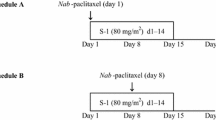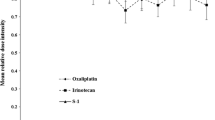Abstract
Background
The toxic effects of S-1 can lead to discontinuation of treatment. Strategies for reducing toxicity without compromising therapeutic effectiveness are required.
Methods
We used the human gastric cancer cell lines MKN28 and MKN45 to examine such strategies in vitro. The cell lines were treated with three different regimens, given on alternate days (alternate-day) or on consecutive days (consecutive-day). On consecutive days, treatment A provided the same total dose as the alternate-day treatment, and treatment B was given for the same number of days as the alternate-day treatment. A fourth group served as control. In vitro, the relative inhibition (RI) of tumor growth by 5-fluorouracil was calculated using the 2-(2-methyl-4-nitrophenyl)-3-(4-nitrophyl)-5-2, 4-disulfophenyl)-2H-tetrazolium (WST-8) method. We also carried out an in vivo experiment in which tumor-bearing nude mice (BALBc/nu-nu) were used to examine the antitumor activity of S-1. Leukocyte counts and gastrointestinal mucosal injury were compared in mice that received alternate-day and consecutive-day treatments.
Results
In vitro, for MKN28, the RI was 22.9% for alternate-day, 34.1% for consecutive-day A, and 37.7% for consecutive-day B treatments. For MKN45, the RI was 51.1% for alternate-day, 52.2% for consecutive-day A, and 50.5% for consecutive-day B treatments. In vivo, for MKN28, the treated groups showed higher inhibition than the control, and inhibition of tumor growth was higher with alternate-day than with consecutive-day treatment. The RI was significantly higher with alternate-day (49.3%) than with consecutive-day treatment (16.2%; P < 0.05). For MKN45, the RI was greater than 50% in both treated groups. With consecutive-day treatment, 5 of the 14 mice used died during treatment. Leukocyte counts were lower in the mice with consecutive-day than with alternate-day treatment, or control. Atrophic changes and inflammatory cell infiltration of the small intestinal mucosa were severe after consecutive-day, but minimal after alternate-day treatment.
Conclusion
Experimentally, alternate-day treatment with S-1 is equivalent to consecutive-day treatment in terms of RI of tumor growth, with lower toxicity.
Similar content being viewed by others
References
Shirasaka T, Shimamoto Y, Ohshimo H, et al. (1996) Development of a novel form of 5-fluorouracil derivative (S-1) directed to the potentiation of the tumor selective cytotoxicity of 5-fluorouracil by two biochemical modulators. Anticancer Drugs 7:548–557
Shiraska T, Yamamitsu S, Tsuji A, et al. (2000) Conceptual changes in cancer chemotherapy: from an oral fluoropyrimidene prodrug, UFT, to a novel oral fluoropyrimidine prodrug, S-1, and low-dose FP therapy in Japan. Invest New Drugs 18:315–329
Tatsumi K, Fukushima M, Shirasaka T, et al. (1987) Inhibitory effects of pyrimidine, barbituric acid and pyrimidine derivatives on 5-fluorouracil degradation in rat liver extracts. Jpn J Cancer Res 78:748–755
Shirasaka T, Shimamoto Y, Fukushima M (1993) Inhibition by oxonic acid of gastrointestinal toxicity of 5-fluorouracil without loss of its antitumor activity in rats. Cancer Res 53:4004–4009
Sakata Y, Ohtsu A, Horikoshi N, et al. (1998) Late phase II study of novel oral fluoropyrimidine anticancer drug S-1 (1 M tegafur-0.4 M gimestat-1 M otastat potassium) in advanced gastric cancer patients. Eur J Cancer 34:1715–1720
Koizumi W, Kurihara M, Nakano S, et al. (2000) Phase II study of S-1, a novel oral derivative of 5-fluorouracil, in advanced gastric cancer. For the S-1 Cooperative Gastric Cancer Study Group. Oncology 58:191–197
Maehara Y (2003) S-1 in gastric cancer: a comprehensive review. Gastric Cancer 6(Suppl 1):2–8
Nagashima F, Ohtsu A, Yoshida S, et al. (2005) Japanese nationwide post-marketing survey of S-1 in patients with advanced gastric cancer. Gastric Cancer 8:6–11
Maehara Y, Sugimachi K, Kurihara M, et al. (1999) Clinical effect of novel oral fluoropyrimidine anticancer drug TS-1 capsule in advanced gastrointestinal cancer patients (in Japanese). Hematology & Oncology 38:468–475
Arai W, Hosoya Y, Hyodo M, et al. (2002) Every-other-day TS-1 administration for recurrent or non-curative advanced gastric carcinoma (in Japanese). Gan To Kagaku Ryoho 29:1651–1655
Arai W, Hosoya Y, Hyodo M, et al. (2004) Alternate-day oral therapy with TS-1 for advanced gastric cancer. Int J Clin Oncol 9:143–148
Arai W, Hosoya Y, Yokoyama T, et al. (2004) A case of type 4 gastric cancer with peritoneal dissemination successfully treated over 2 years by alternate-day administration of TS-1 (in Japanese). Gan To Kagaku Ryoho 31:237–240
Ovejera AA, Houchens DP, Barker AD (1978) Chemotherapy of human tumor xenografts in genetically athymic mice. Ann Clin Lab Sci 8:50–56
Lipkin M, Sherlock P, Bell B (1963) Cell proliferation kinetics in the gastrointestinal tract of man II cell renewal stomach, ileum, colon, and rectum Gastroenterology 45:721–729
Clarkson B, Ota K, Ohkita T, et al. (1965) Kinetics of proliferation of cancer cells in neoplastic effusions in man. Cancer 18:1189–1213
Shirasaka T (2000) Conceptual changes in cancer chemotherapy. Biochemical modulation of 5-FU from bench to clinic. Jpn J Cancer Chemother 27(Suppl) II:193–205
Hojo H (1977) Establishment of cultured cell lines of human stomach cancer origin and their morphological characteristics (in Japanese). Niigata Med J 91:736–752
Katayanagi N (1990) An experimental study of anticancer agent sensitivity test in human gastric cancer cell lines by flow cytometry (in Japanese). Nippon Geka Gakkai Zasshi 91:827–836
Iwatani Y, Kamigaki T, Suzuki S, et al. (1999) Proliferating cell nuclear antigen as a predictor of therapeutic effect of continuous 5-fluorouracil administration in gastric cancer: Int J Oncol 14:965–970
Fujiwara H, Terashima M, Irinoda T, et al. (2003) Superior antitumor activity of S-1 in tumours with a high dihydropyrimidine dehydrogenase activity. Eur J Cancer 39:2387–2394
Fukushima M, Satake H, Uchida J, et al. (1998) Preclinical antitumor efficacy of S-1:a new oral formulation of 5-fluorouracil on human tumor xenografts. Int J Oncol 13:693–698
Terashima M, Fujiwara H, Takagane A, et al. (2003) Prediction of sensitivity for fluoropyrimidines by metabolic and target enzyme activities in gastric cancer. Gastric Cancer 6:71–81
Fukushima M, Shimamoto Y, Kato T, et al. (1998) Anticancer activity and toxicity of S-1, an oral combination of tegafur and two biochemical modulators, compared with continuous i.v. infusion of 5-fluorouracil. Anticancer Drugs 9:817–823
Suzuki M, Sekguchi I, Sato I, et al. (1996) Combined effects of S-1, a new form of oral Tegafur, plus modulators on ovarian cancer in nude rats. Chemotherapy 42:452–458
Ikeda K, Masuda H, Yoshisue K, et al. (1997) Disposition of components of new anti-cancer drug S-1(8): species differences, dose proportionality (in Japanese). Xenobio Metabol and Dispos 12:656–667
Sakuramoto S, Sasako M, Yamaguchi T, et al. (2007) Adjuvant chemotherapy for gastric cancer with S-1, an oral fluoropyrimidine. N Engl J Med 357:1810–1820
Author information
Authors and Affiliations
Corresponding author
About this article
Cite this article
Arai, W., Hosoya, Y., Haruta, H. et al. Comparison of alternate-day versus consecutive-day treatment with S-1: assessment of tumor growth inhibition and toxicity reduction in gastric cancer cell lines in vitro and in vivo. Int J Clin Oncol 13, 515–520 (2008). https://doi.org/10.1007/s10147-008-0780-4
Received:
Accepted:
Published:
Issue Date:
DOI: https://doi.org/10.1007/s10147-008-0780-4




